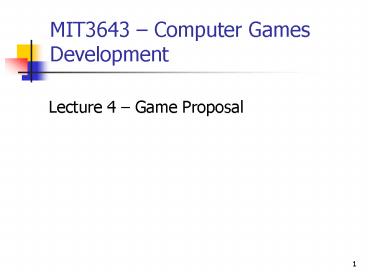MIT3643 Computer Games Development - PowerPoint PPT Presentation
1 / 13
Title:
MIT3643 Computer Games Development
Description:
But only the best designs will be selected for development. ... cool '70s feel and a conspiracy theme: GoldenEye meets the CIA in a sharp-cut suit. ... – PowerPoint PPT presentation
Number of Views:59
Avg rating:3.0/5.0
Title: MIT3643 Computer Games Development
1
MIT3643 Computer Games Development
- Lecture 4 Game Proposal
2
Lecture Outline
- Game Design Ideas
- Design Proposal
- Key Design Decisions
3
Part 1 Game Design Ideas
- Most games companies have a constant demand for
new game designs. - But only the best designs will be selected for
development. - Design ideas come from various sources
- Reusing existing game ideas
- Brainstorming
- Input from the publisher market-led ideas
- The design will evolve from a one page pitch
(proposal) to a full specification, which can
reach several hundred pages.
4
Reusing Game Ideas
- Existing games are the primary source for new
game ideas. - Almost every game is a remake of an existing
game - with extra features from brainstorming or market
response. - Thus, new games evolve, rather than appear.
- Consider is it possible to make a completely
original game?
5
Other Sources for Ideas
- A brainstorming session is a very free
discussion to reach new game ideas. - There is no leader everyone is equal.
- Ideas are raised very quickly, to get maximum
creativity. - One problem can be remembering what was talked
about. Worth taking notes.
- Publishers may suggest game ideas to trusted
developers. - These ideas will be those derived from market
research.
6
Part 2 Design Proposal
- A one-page proposal is the most basic form of
game design. - Rarely more than a single page.
- It is used to gain publisher interest.
- A development company will usually maintain a
portfolio of game proposals.
7
Proposal Content
- Take the Bullet
- Jack Travis, a bodyguard of unflinching
dedication, is hired by a presidential candidate
known as Kincaide, to guard against a terrorist
group The Children of Gabriel. But Jacks
loyalties will be tested to the limit as he
realises the truth behind the terrorists, and the
ambitions of his boss
- Game Title
- Memorable and preferably short.
- Story / Context
- A few lines to set the scene.
- Should engage the readers interest.
- Game Art
- Style or concept art.
- Game mock-up or logo.
- We will cover artwork in more detail later -
using a simple logo here
8
Proposal Content (cont)
- Game-play description
- Simple, one sentence only.
- Comparing to other games is useful.
- By now, the reader should be eager to play the
game. - Platform
- What computers or consoles is the game intended
for. - Mention any multiplayer support and other unique
hardware features.
- First person shooter with a retro-cool 70s feel
and a conspiracy theme GoldenEye meets the CIA
in a sharp-cut suit. - Dreamcast. Uses light-gun for aiming and movement
- Split-screen and multi-link multiplayer support.
9
Proposal Content (cont)
- Target Market
- Briefly identify who will buy your game.
- Demonstrate that your game makes business sense.
- Can separately list USPs (Unique Selling Points)
- Competitors
- What similar games have been or will be released.
- Research carefully.
- One line each, identifying differences to your
game.
- FPS and light gun game players, age 10. Geared
for US and Europe. Genre (FPS) and theme
(conspiracy) are widely popular. - Few FPS titles on Dreamcast.
- Unique use of gun interface.
- Topical interest for the US.
- Unreal Tournament on Dreamcast, multiplayer only,
no story or single player mode. - Metal Gear Solid on the PS1 has conspiracy / spy
theme, but uses third person and has less
character and style.
10
Part 3 Key Design Decisions
- There are three key decisions to be made in the
very early stages of creating a game design - Core game-play style
- Point of view
- Control method
- These decisions together with a basic story are
enough to create proposals and mock-ups for a
game. - These choices can be difficult to change once
game development has begun. They should be tested
by prototyping if possible.
11
Core Game-play Style
- This is effectively the same as genre.
- It is the decision about the basic actions you
perform in the game, e.g. - Real-time resource management and unit-based
battle (RTS games like Dawn of War). - Real-time movement around environments shooting
enemies (FPS games like Doom 3). - This is the most fundamental aspect of a game, if
you change this, then you are probably making a
different game. - Make sure you are very clear about this before
you start writing any game design.
12
Point of View
- This is the choice of camera view in a game.
- Some possibilities are
- First person - you see the scene through a
characters eyes, e.g. Doom 3 (Note FPS First
Person Shooter) - Third person the camera focuses on a main
character in the environment, e.g. Splinter Cell. - God-view the camera looks down on a scene from
far away, e.g. Rome Total War - Many genres have a standard point of view .
- Ensure you have a good reason to use a
non-standard point of view.
13
Control Method
- This decision has two parts
- What hardware will be used to control the game,
e.g. mouse, mouse keyboard, joypad, joystick,
lightgun, etc. - Will the user control a character actions
directly? Or will they use menus, buttons or
commands to direct the game actions? Or a
combination of both? - The first decision is often simpler.
- Both decisions are important and should be made
early.































